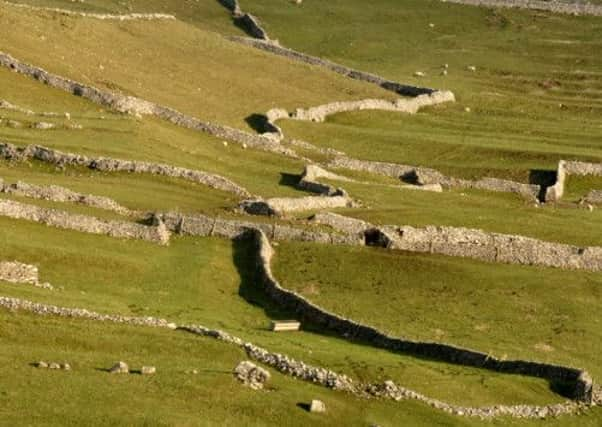Walls that mark out history in landscape


The majority of people, either walking or driving through the uplands of Yorkshire, cannot help but be amazed at the mile upon mile of dry stone walls that partition the valley floor into meadows and pastures and the eye-catching constructions that run straight as a die up the steep hillsides and over the brows of the hills. And all these walls have endured for centuries without a bucket of mortar.
On closer inspection it is noticed that the enclosures close to habitation seem to be a lot smaller (often less than an acre) and of irregular shape. The pattern of these smaller paddocks may be increasingly difficult to spot with the progression of development around individual farms and villages but plenty of examples still remain in the Pennines and Dales. Further out, the fields are generally more ordered with straighter sections of wall and are much larger (five to ten acres). As the land rises the walls seem to get straighter still and are constructed to a more uniform pattern.
Advertisement
Hide AdAdvertisement
Hide AdMore detailed examinations reveal differences which shed some light on their history.
Agricultural walls, although undoubtedly in existence from Neolithic times, did not make an appreciable mark on the landscape until the 13th century when the monasteries began to enclose both the surrounding lands and distant pastures. The monks had great skills as wallers which can still be seen today. However, the objective regarding the agricultural walls was threefold in that the walls provided some form of definitive boundary marker, exclusion or containment of livestock and also enabled the land to be cleared of stone.
The walls we see today forming the small crofts and paddocks close to habitations are thought to date from the 15th and 16th centuries at a time when there was a move towards individual plots as opposed to the earlier communal farming.
Elizabethan legislature authorized the enclosure of some of the commons and waste to encourage a better utilization of the land. These plots were generally engaged in the growing of crops and livestock grazing was continued on the remaining common land. The walls are generally built from random stone with the larger boulders in the bottom and smaller irregular shaped stones higher up. They are often disproportionately wide at their base but this is often due to the effects of gravity over five centuries.
Advertisement
Hide AdAdvertisement
Hide AdMany of these walls have little or no fillings and lack any definable shaped topstones and the course of the wall is invariably crooked.
The 16th century also saw a rise in population and a growing market for wool, both for home consumption and foreign trade. Today it seems the sheep’s fleece is not the highly valued product it once was. Until twenty-five or so years ago wool was, weight for weight, the most expensive commodity leaving a farm.
Inevitably this led to the demise of the common field system as independent farmers walled off sections of the common which could be more easily controlled.
The new enclosures were now expanding farther up the valleys and hillsides. Although still relatively small, the fields seem to have more linear sections of wall and a greater form of order to them.
Advertisement
Hide AdAdvertisement
Hide AdThis process continued towards the latter end of the eighteenth century when there was pressure for further sub-division of the common lands and this led to the series of Enclosure Acts.
The long straight, uniform walls that we see today in the upper areas owe their existence to these Acts of Parliament. Furthermore, the Acts specified the dimensions of these walls. For example in 1788, enclosures in Grassington were to be formed with walls six feet high, 34in wide at the bottom and battered to give a width of 16in under the topstones.
The Acts of Enclosure provided work for many walling gangs, some of who also worked in lead mines in wet weather.
I have heard it said that many of these later walls in our region were built by French prisoners of the Napoleonic wars (1803-15) but there is no documentary evidence, but it seems the efforts of these men were employed, alongside convicts, in the building of the walls on Dartmoor.